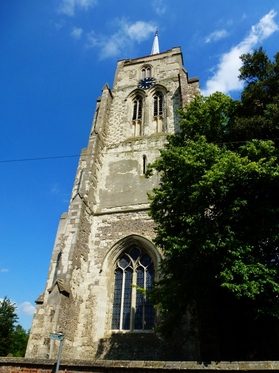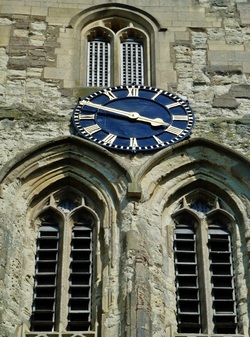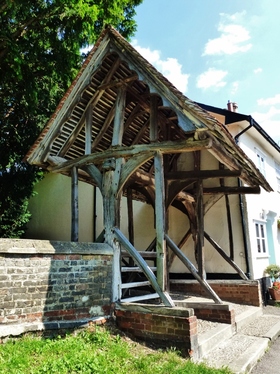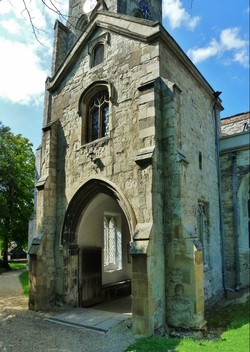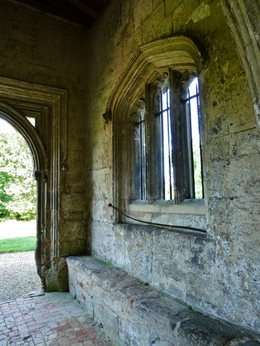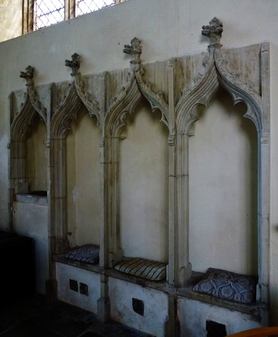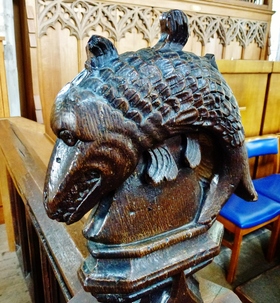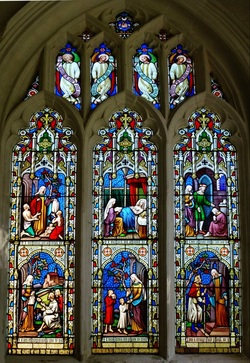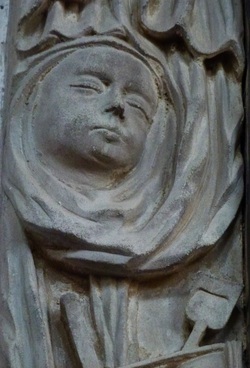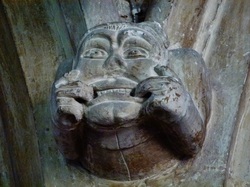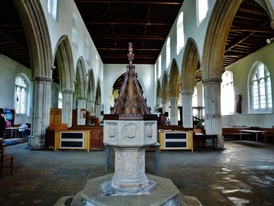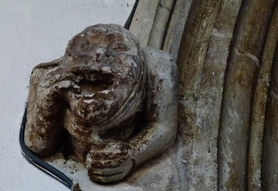St. Mary, Ashwell.
Grouches and graffiti.
You can see Ashwell’s tower with its short octagon and spike from a long way off over the large hedgeless fields that cover the low hills of north Hertfordshire. It stands head and shoulders above its neighbours not just in height, but in elegance and craftsmanship, being built with crisply cut chalk rather than the more ubiquitous flint. This prodigy is set in a village centre that looks like a town frozen in its development, probably to the relief of its inhabitants. There are plenty of timber framed buildings, plenty of Jacobean and Stuart brick, including the little fifteenth century jettied museum and the Merchant Taylors school of 1681, some infill of the Georgian and early Victorian period, but until fairly recently growth beyond the original footprint of the village was limited. Now, however, commuter ghettos have sprung up, predominantly to the south of the centre, packing p.v.a windowed boxes cheek by jowl. These estates could be anywhere, and swamp the individual character of any place that they infect. Luckily, it is for the moment possible to avoid them on the way to the church, at least until greed adds more, so let us raise our eyes from this particular gutter, and head for that stupendous tower.
The entrance to the churchyard is through a mediaeval two-bay timber lych-gate, where the corpse would halt for the first part of the burial service, lych being an old English word for body. The body of the church was rebuilt in the mid fourteenth century, after the lower section of the tower was completed. This remains fossilised within the extended tower, its battlements caught like flies in amber half way up the monster we see today. After the rest of the church was finished, there seem to have been several campaigns when it was decided to go just that bit higher, topping out the tower in 1381. The church belonged to Westminster Abbey, and is certainly not the work of provincial masons, but no one knows exactly why such a prodigious church was built here; there was no college, nor were there a large number of chantries. The tracery of the large west window is interesting, being like nothing so much as Scottish loop tracery of two hundred years later. The tower has had to be much restored; by the 1920s the chalky stone was so weathered that it looked like melted cheese.
Grouches and graffiti.
You can see Ashwell’s tower with its short octagon and spike from a long way off over the large hedgeless fields that cover the low hills of north Hertfordshire. It stands head and shoulders above its neighbours not just in height, but in elegance and craftsmanship, being built with crisply cut chalk rather than the more ubiquitous flint. This prodigy is set in a village centre that looks like a town frozen in its development, probably to the relief of its inhabitants. There are plenty of timber framed buildings, plenty of Jacobean and Stuart brick, including the little fifteenth century jettied museum and the Merchant Taylors school of 1681, some infill of the Georgian and early Victorian period, but until fairly recently growth beyond the original footprint of the village was limited. Now, however, commuter ghettos have sprung up, predominantly to the south of the centre, packing p.v.a windowed boxes cheek by jowl. These estates could be anywhere, and swamp the individual character of any place that they infect. Luckily, it is for the moment possible to avoid them on the way to the church, at least until greed adds more, so let us raise our eyes from this particular gutter, and head for that stupendous tower.
The entrance to the churchyard is through a mediaeval two-bay timber lych-gate, where the corpse would halt for the first part of the burial service, lych being an old English word for body. The body of the church was rebuilt in the mid fourteenth century, after the lower section of the tower was completed. This remains fossilised within the extended tower, its battlements caught like flies in amber half way up the monster we see today. After the rest of the church was finished, there seem to have been several campaigns when it was decided to go just that bit higher, topping out the tower in 1381. The church belonged to Westminster Abbey, and is certainly not the work of provincial masons, but no one knows exactly why such a prodigious church was built here; there was no college, nor were there a large number of chantries. The tracery of the large west window is interesting, being like nothing so much as Scottish loop tracery of two hundred years later. The tower has had to be much restored; by the 1920s the chalky stone was so weathered that it looked like melted cheese.
The churchyard has thankfully not been cleared of gravestones, a barbarism that has left so many churches adrift in a green desert. Nor has it been packed with the shiny hard marble so beloved of modern monumental masons. It is only because the tower is of such an astonishing size that it takes a moment or two to realise that the fifteenth century two storeyed south porch is actually higher than the aisle. It is a shame that its vaulting is Victorian, with flowery bosses. On the other side of the church is a much smaller single storey porch, unrestored, and with a nice brick floor. Inside the church there is a feeling of spaciousness and light, with a wide nave and Decorated arcades with quatrefoil piers which change their details from east to west. Above them the headstops of the dripmoulds are worth study, depicting beasts as well as men with toothache and headaches, literally pulling faces. In the chancel the lacy trees outside can be seen through the clear glass in the net like tracery of the wide early Perpendicular windows, which fill the white walled church with such brilliant light.
This makes the colourful mid nineteenth century window by William Wailes depicting the works of mercy all the more vivid in its isolation behind the mediaeval screens of the south aisle’s chapel. For such a splendid church there is little in the way of furnishing: most of brasses and stained glass has long gone. There are however two very fine bench ends, one with a gryphon, one with a leaping toothed heraldic dolphin. The chancel has been used as a separate chapel since the high altar was moved west; as so often this leaves an aesthetic void where one expects the focus of the church to be. Here the main altar is at the west end of the chancel with a modern figure of Christ hanging over it, leading to a sense of anti-climax beyond, though there is at least an old communion table under the east window, so that the fourteenth century piscina and sedilia do not look completely pointless. Below them are set some late mediaeval tiles, and opposite is a wall tablet to John Baldwyn of 1689, with mournful angel faces amongst the memento mori. It is at the other end of the church that the most interesting space lies, under the tower. It has massive internal buttresses covered with big-boned blind tracery reaching out into the nave, and characterful corbels meant for vaulting up in the corners inside. It is worth climbing the tower to see the fine masonry of the vaulted passages cut into its walls; don’t miss the recessed handrail on the stair.
It is underneath the tower that the most famous of Ashwell’s large collection of graffiti can be found: the amazingly rare and detailed drawing of Old St.Paul’s in London, and the inscriptions dated 1350 and 1361 bemoaning the village’s losses to the plague and to a great storm. These are written in Latin, most probably by priests, and thirty rather illegible inscriptions are scattered through the church; several seem to be workmen’s complaints, others old sayings and saws. It is difficult for us to get into the minds of those who wrote these lines, whether schoolboys learning Latin or the masons that built the church, but the building itself offers a window into their pastoral world of pestilence and piety.
This church is generally open, despite the growth of the village into a small town; it’s a good area for unlocked churches, and there’s a feeling of local pride that hopefully will keep it so. It lies in to the north of the High Street on Mill Street, in the centre of town.
This church is generally open, despite the growth of the village into a small town; it’s a good area for unlocked churches, and there’s a feeling of local pride that hopefully will keep it so. It lies in to the north of the High Street on Mill Street, in the centre of town.
All rights reserved for this entire site. Copyright reserved to stiffleaf for all text and images, which may not be reproduced without my permission.
